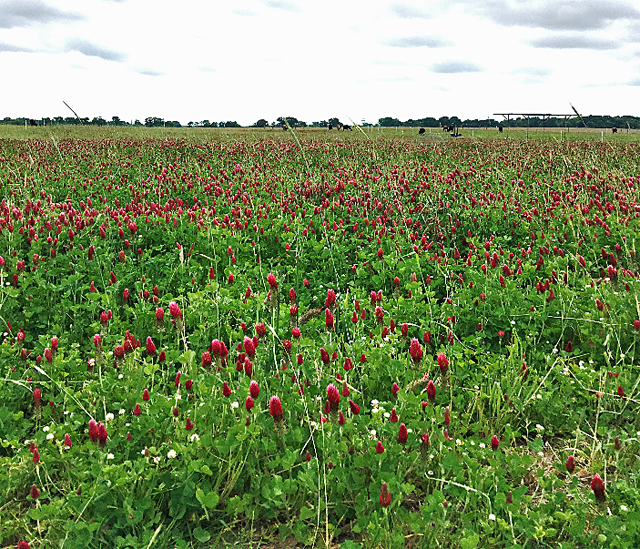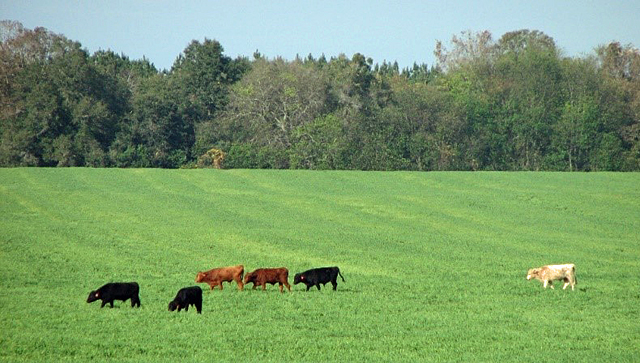Jose Dubeux – University of Florida – NFREC Forage Management Specialist
Have you booked your seeds for cool-season pastures?
Fall is rapidly approaching, so it is time to book your cool-season forage seeds. Cool-season forages represent a great opportunity to improve livestock gain with reduced cost. Whether you are raising stocker cattle or developing heifers to replace your mature cows, it is possible to stock 1.5 to 2 head per acre and get 2 lbs./head/day gain over the 100-120 day period just on cool-season forages. Cool-season forages are also a great option for first-calf heifers, or to improve nutrition for mature cows after calving, resulting in greater reproduction efficiency of the herd. Because North Florida is one of the best places in the country to grow cool-season forages, you cannot miss this opportunity (Figure 1). Mild winter temperature increases the grazing season during this period in North Florida, resulting in greater pasture productivity compared to other regions with harder winters.
In North Florida, the recommended planting dates for cool-season forages range from October 15 through November 15, which is only two months away. If you are overseeding on dormant warm-season grasses, such as bahiagrass or bermudagrass, you need to wait for the first frost before no-till planting into permanent pastures. If you are planting on a prepared seedbed, you can plant earlier. Seed depth, seed rates, and fertilization are important details that require close attention (see Cool-season forage recommendations for specific information on different forage varieties). Attention to detail during the establishment phase can affect the ultimate productivity of annual pastures.
There are numerous forage options for producers, but mixtures of small grains, annual ryegrass, and clovers rank among the top choices (Figure 2). Cool-season forage recommendations are based on variety trials performed in several locations. For this region the best small grain options are Rye, Triticale, and Oats. There are early and late varieties that can be blended to boost the number of overall grazing days, depending on the specificity of your system. Locally bred forages are often better than varieties developed in other regions, because of day length adaptation and disease resistance. Legend 567, for example, is a rust resistant oat released recently by UF/IFAS. Annual ryegrass stretches the grazing season by complementing the small-grain growth curve, therefore, it is wise to plant mixtures of these grasses. Earlyploid, Prine, and Jumbo are examples of annual ryegrass varieties well adapted to Florida. Mixing early and late varieties also works with clovers. If you mix earlier clovers, such as Crimson, with mid- to late-clovers such as ball clover and red clover, you can also extend the clover grazing season. Whenever you are mixing seeds, remember to use a reduced seeding rate as compared to monocultures. At UF/IFAS-NFREC in Marianna, we used a clover mixture with 15 lbs. of Crimson, 6 lbs. of Southern Belle red clover, and 3 lbs. of Ball clover last Fall and it worked well (Figure 2). When you mix forages with different rooting depths and timing of growth, pasture productivity increases because of more efficient utilization of both water and nutrients. Moreover, clovers can add nitrogen (N) to the system via biological N2-fixation, so they require less nitrogen fertilization.

Figure 2. Cool-season mixture (FL401 Rye, RAM Oat, Crimson, Red, and Ball clover) at UF/IFAS-NFREC in Marianna. April, 2016. Photo credit: Jose Dubeux
In grazing systems, producing forage is just one step in the process. In order to be productive, you must also manage the grazing animals to efficiently utilize annual pastures. In grazing trials conducted at the UF/IFAS-NFREC Marianna Beef Unit, on cool-season forages, the average stocking rate along the season was 1.5 to 2.0 steers per acre (600-lbs. steers). Stocking rates should be adjusted as the forage growth rate varies through the season. Grazing animals must also be efficient in the conversion of forage into animal products. The genetics and health care of the animals are crucial to maximize gains and get the most out of your cool-season grazing. If you haven’t booked your cool-season seeds yet, contact your local county extension agent, who can help you determine the best forage options for your farm.
- Grazing Cover Crops is a Triple Win! - August 15, 2025
- How are My Cool-season Forages Recovering from the Snowfall and Low Temperatures? - January 31, 2025
- Integrated Crop-Livestock Systems Improve Soil Health - July 26, 2024

